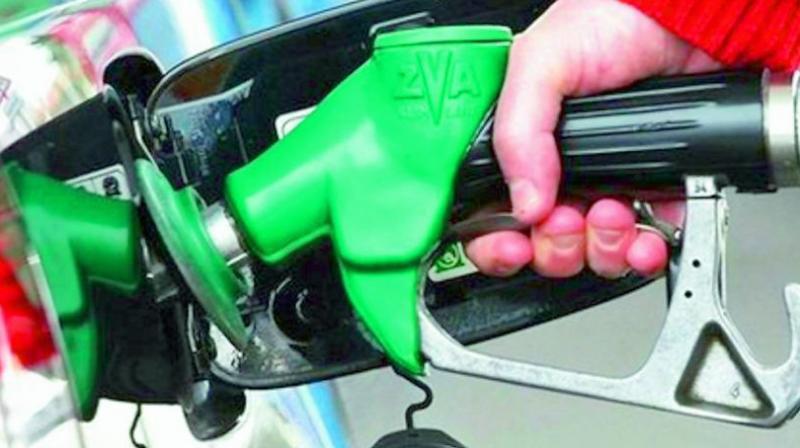Centre makes Rs 1.6 trillion more on fuel
At present, a consumer pays additional excise duty of Rs 11.77 on every litre of petrol and Rs 13.57 a litre on diesel.

Hyderabad: Despite crude oil prices falling internationally, the Centre has collected over Rs 1.6 lakh crore (Rs 1.6 trillion) in additional excise duty last year, a study of fuel consumption in India revealed.
The additional excise duty refers to an aggregate increase in the indirect tax imposed by the NDA government on petrol and diesel from November 2014 to January 2016 in eight instalments to gain from the falling global crude oil prices.
At present, a consumer pays additional excise duty of Rs 11.77 on every litre of petrol and Rs 13.57 a litre on diesel.
According to the data available with the Petroleum Planning & Analysis Cell, a wing of the Union ministry of petroleum and natural gas, Indians have consumed 3210,64,25,294 litres or 3,210.64 crore litres of petrol and 9060,92,88,530 litres or 9,060.92 crore litres of diesel in financial year 2016-17.
This netted the government Rs 37,789.26 crore from petrol and Rs 1,22,956.80 crore from diesel in additional excise duty during the period between April 1, 2016 and March 31, 2017. The total additional excise duty paid by users on petrol and diesel last fiscal is Rs 1,60,746.06 crore, affecting 21 crore registered vehicle owners in India.
The additional excise duty on petrol and diesel makes up 41.3 per cent of the total excise duty collection of Rs 3.87 lakh crore in fiscal 2016-17.
The additional excise duty had mopped in Rs 96,677 crore in fiscal 2015-16 and Rs 16,578 crore in fiscal 2014-15 for the Central government.
As global crude oil price crashed from nearly $100 a barrel on January 1, 2014 to $50 a barrel in November 2014, it allowed oil companies to end their losses and also let the government hike excise duty through a special levy to shore up its finances.
In absence of additional revenue from fuel, the government would have found it difficult to meet fiscal deficit targets and control rupee fall. The government then would have found it difficult to attract investors to a country.
In spite of demand from people, experts claim that the government would not cut additional excise duty until economy is back on track and until it can increase revenue from other sources.
Speaking to this newspaper, Mr Deven R. Choksey, the managing director of KR Choksey Shares & Securities, said that the government is trying to repair the country’s balance sheet and hence it will not reduce excise duty until economic growth rate touches 8-9 per cent.
“The government will not cut excise duty until inflation is in comfortable zone,” said India Ratings chief economist Devendra Pant.
“The government will not reduce the excise duty any time soon as it has to meet the fiscal deficit target and its revenue collection from other sources is not improving greatly. Since demand is subdued and inflation is muted, the government cannot forego this revenue,” Mr Pant explained. According to a study conducted by Nielsen (India) Pvt Ltd for Petroleum Planning and Analysis Cell (PPAC) in 2014, trucks are highest consumer of diesel, while two-wheelers are the largest consumer of petrol.
When calculated on the basis of Nielsen consumption data, trucker users had borne largest tax burden by paying approximately Rs 34,735 crore in additional levy in FY16-17, followed by two-wheeler users who paid Rs 23,210 crore of additional tax, private diesel cars Rs 16,168 crore, private petrol cars 12,973 crore among others.
